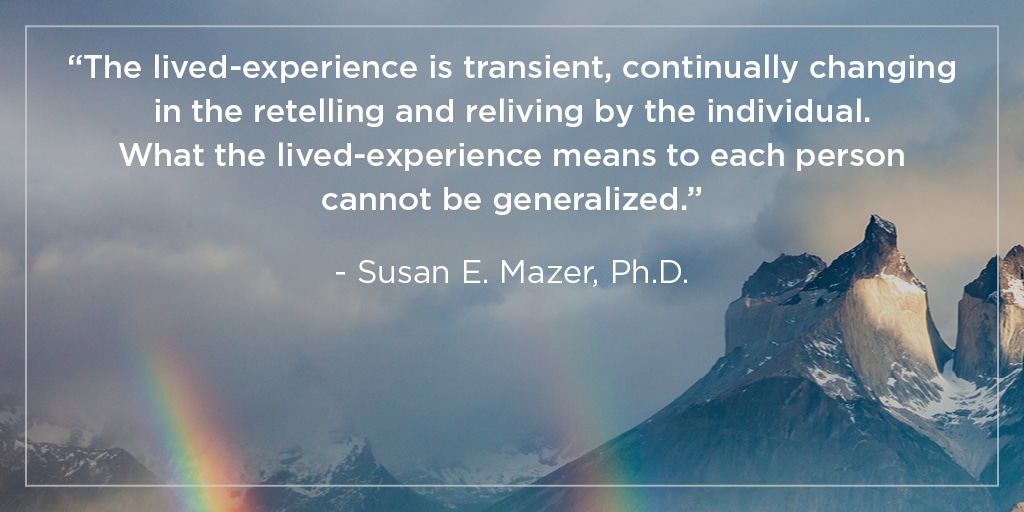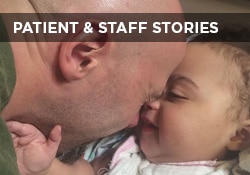This website uses cookies so that we can provide you with the best user experience possible. Cookie information is stored in your browser and performs functions such as recognising you when you return to our website and helping our team to understand which sections of the website you find most interesting and useful.

Susan E. Mazer, Ph.D. Blog
Thoughts and ideas on healthcare
Hi, and welcome to my blog! I'm Susan E. Mazer -- a knowledge expert and thought leader on how the environment of care impacts the patient experience. Topics I write about include safety, satisfaction, hospital noise, nursing, care at the bedside, and much more.
The Patient Experience: How to Set the Stage for Recovery
April 16, 2021
Let’s talk about the patient experience! The movement is over a decade old, has been described from various perspectives, yet remains a challenge to actually define and operationalize. My goal with this article is to clarify why this is challenging and share some information that could help.
What is an “Experience”?
To better understand what the patient experience is, let’s first define experience. An experience is defined by Miriam Webster as:
“A direct observation of or participation in events as a basis of knowledge.”
This definition implies an objective understanding of something. However, this does not refer to the subjective knowledge an individual has from their own life. That is where the lived-experience comes in.
What is the “Lived-Experience”?
Oxford References defines the lived-experience as:
“Personal knowledge about the world gained through direct, first-hand involvement in everyday events rather than through representations constructed by other people.”
This definition of the lived-experience comes closer to what the patient experience movement is wanting to inform. The patient experience wants to know the beingness of patient-hood. The goal is to know how it was for the person whose life has stopped, whose body has betrayed them, or whose independence has been taken by an illness.
The lived-experience is transient, continually changing in the retelling and reliving of the individual. What the lived-experience means to each person cannot be generalized. We depend on the recollection and narrative coming from the individual, rather than from an objective report. The lived-experience is not a thing. It is not finite, nor does it exist in the natural world.
That said, the patient experience as a lived-experience cannot be fully understood using a set of questions or measures. While the HCAHPS survey attempts to translate the patient experience into quantitative measures, it offers only multiple-choice questions that cannot fully be answered or understood without the narrative coming directly from the patient.
During this time of evidence-based practice, the “anecdote” has been placed near the bottom of the list of credible data. Anecdotes are brief, subjective accounts from one person or about one situation. Unlike formal studies, an anecdote cannot be replicated and controlled.
Nonetheless, an anecdote reveals more about the patient’s experience than any survey could. When we tell our stories about what has happened to us, it includes not only the “facts,” but infers directly and indirectly to the social and personal context of our life events. Further, one story can represent many other stories.
The lived-experience belongs to and is the patient. They come to their own understanding and make meaning of everything they see, hear, and that is done to them. Over time, “what happened” changes as it is further interpreted and relived.
How do patients endure such dramatic change, uncertainty, and loss of autonomy which only a short time ago was fully under their control? More so, what meaning do they attribute to everything that happens to them, to the people they engage with (voluntarily or not), and to their current surroundings?

Noise Unwanted & Uncontrolled
When looking at the lived-experience in relation to the patient experience, assessment and ongoing modification on the patient environment is a requisite. The person/environment relationship is irreducible and is informed by sensory perceptions. That translates into the patient experience as everything a patient sees, hears, touches, tastes, and smells. Further, when the environment is incompatible with the capacity and purpose of the individual, stress, and anxiety occur.
That said, what a patient hears is perhaps the most dominant environmental stressor and is by far the most offensive. As Nightingale said, “Unnecessary noise is the cruelest absence of care.” In everyday life, we are taught to be considerate, to mitigate noises that are clearly disruptive to others, and to demonstrate that we are caring and responsible. When that doesn’t happen, especially in the environment where care takes place, it breaks the promises made by the hospital to protect their patients from intrusion and distraction while providing the best care.
Noise, Patients, & Hospitals
Whether in the hospital, clinic, or emergency room, distractions (i.e. second-hand conversations) are not under the control of the patients. Families have no authority over other families or the staff. Patients may feel helpless to control what their own family members do. Thus, it is up to the hospital staff to deal with unruly people and unacceptable circumstances on behalf of the patients.
Living the life of a sick person today is not fun. The patient feels denied respect and compassion when their needs are either questioned or disregarded. Although the length of time one is sick may be short or may be long, the need for conscious, purposeful consideration is the same.
During my research and through writing my paper, Pain and the Patient Experience, I found that the efforts to understand the suffering of another or to accurately describe what it feels like, is never fully satisfied. Pain is about intensity, meaning, tolerance, and so many social and cultural factors that what it actually “feels like” is secondary to how it is experienced. And, explaining to another person can only be done by inference or comparisons. I also found that it is not uncommon that the perceptions and expectations of a caregiver may not coincide with what is going on for the patient. The lived-experience of one person as told to another cannot be debated. It is their truth in that moment.
Setting the Stage for Recovery
The C.A.R.E. Channel, now in its 29th year, is produced to set the stage for recovery, to condition the environment to minimize suffering and support healing. It serves as a reminder that healing is happening and provides comfort and care to the patient 24-hours a day, whenever the patient finds it helpful.
C.A.R.E. offers respite and demands nothing. Showcasing the most stunning natural landscapes helps distract patients and their visitors from the stresses and suffering of the moment. It can serve as a reminder of the awesomeness of nature and what makes life so rich. Further, The C.A.R.E. Channel prompts us to respect and support a calming and healing environment.
Let each of us act with consideration as an expression of empathy and take the needed steps of caring to express compassion.
For more information on the patient experience and noise, download my white paper – Hospital Noise & the Patient Experience.










